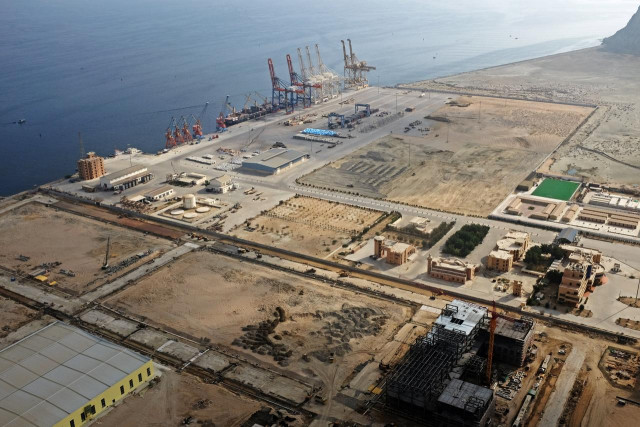Improving trade balance with China
Pakistan must renegotiate trade deal to promote exports to Chinese markets

A general view of Gwadar port in Gwadar, Balochistan. PHOTO: REUTERS
What is even more depressing is that the import bill from China is now double the five-year average of FY11-15 but export earnings are visibly lower than that average.
Pakistan began registering a surge in imports from China after the launch of China-Pakistan Economic Corridor (CPEC), an integral part of Beijing’s ambitious Belt and Road Initiative, back in 2013.
Imports of Chinese machinery and equipment meant for CPEC projects initiated in Pakistan explain the surge to a great extent. But overall imports from China rose also due to growing demand for – and extended use of – relatively less expensive Chinese industrial, agricultural and consumer products across Pakistan.
On the other hand, Pakistan could not sustain an increase in exports to China, seen in FY13 and FY14, in later years. What is more worrying is that exports to Beijing not only stopped growing after FY14 but began sliding and did never touch FY14 level again. And there is not much hope for exports rising to that level even in the current fiscal year.
The problem with Pakistan’s exporters and policymakers is that they are complacent to the core. Once they hit a high performance mark in a given market, they never bother to aim for reaching an even higher mark next year.
They leave things to chance. That is, by the way, in our national psyche. We are not good strategists. We are not good planners. We are not hard workers. Almost always, we leave things to chance – to our convenience.
Logic demands that well before the launch of CPEC, Pakistan’s policymakers should have made detailed, realistic projections about how this would impact bilateral trade with China – the second largest economy of the world and the greatest export power on Earth.
Policymakers claim they did it at that time but they refuse to accept the reality that projections made at that time were not made realistically, keeping every important detail in view.
Private-sector representatives and exporters’ lobbies in the country also apparently failed. With the exception of Pakistan Business Council, none of them carried out their own research on how CPEC could impact bilateral trade and what exporters needed to do to exploit trade enhancement opportunities that were going to open.
And now we are here – exporting less than $2 billion a year to China and footing an annual Chinese import bill of more than $10 billion.
Review of tariff lines
The outbreak of the novel coronavirus has led to economic recession in major parts of the world and year 2020 is going to end with a deeper recession than the one seen in the wake of the global financial crisis more than a decade ago.
A change in trade policy factoring in all the possibilities in global trade dynamics is a must. There is perhaps a greater need for promoting intra-regional trade to take advantage of the economy of trade.
The US and China are already involved in what experts of international trade call nationalisation of commerce or commercial nationalism, which means lesser trade between the top two economies of the world.
What does it mean to Pakistan? How the country can position itself to promote its export volumes. Which import tariff lines need to be reviewed once again to encourage cheaper export of raw material from China with the specific purpose of exporting more, in turn, to that country? These are the issues that the policymakers must address quickly.
PM’s Adviser on Commerce Abdul Razak Dawood has promised to slash tariffs on more than 300 categories of imported items that are widely used as raw material for the export of goods. That’s a good start.
In coming years, when CPEC projects are completed and run in full steam, Pakistan is bound to register a further increase in imports, mainly from China but also from other nations.
It is time to dedicate some technical and financial resources to drawing a full map to determine how exports to the entire world, and more specifically to China, can grow. A foreign currency-starved nation like Pakistan cannot afford to run a huge trade deficit with any trade partner – let alone the second largest economy of the world.
Islamabad must renegotiate some provisions of its trade deal with Beijing with the exclusive purpose of promoting exports to Chinese markets. It is desirable and it is possible.
The Chinese side would most likely appreciate that by allowing greater concessions in tariff lines of imports from Pakistan, it would help its industries and businesses do more trade with a country where there are greater chances for them to penetrate via CPEC. Won’t they?
Amid growing unease between Sino-Indian relationship, China can easily shift part of its imports that were earlier sourced from India to Pakistan now. It is up to the subject specialists to come up with viable options for reducing Islamabad’s trade deficit with Beijing.
It is up to the political leadership of the two countries to sort out this issue as early as possible. That will also deepen their strategic geopolitical ties.
the writer is a mechanical engineer and is doing masters
Published in The Express Tribune, June 8th, 2020.
Like Business on Facebook, follow @TribuneBiz on Twitter to stay informed and join in the conversation.



















COMMENTS
Comments are moderated and generally will be posted if they are on-topic and not abusive.
For more information, please see our Comments FAQ